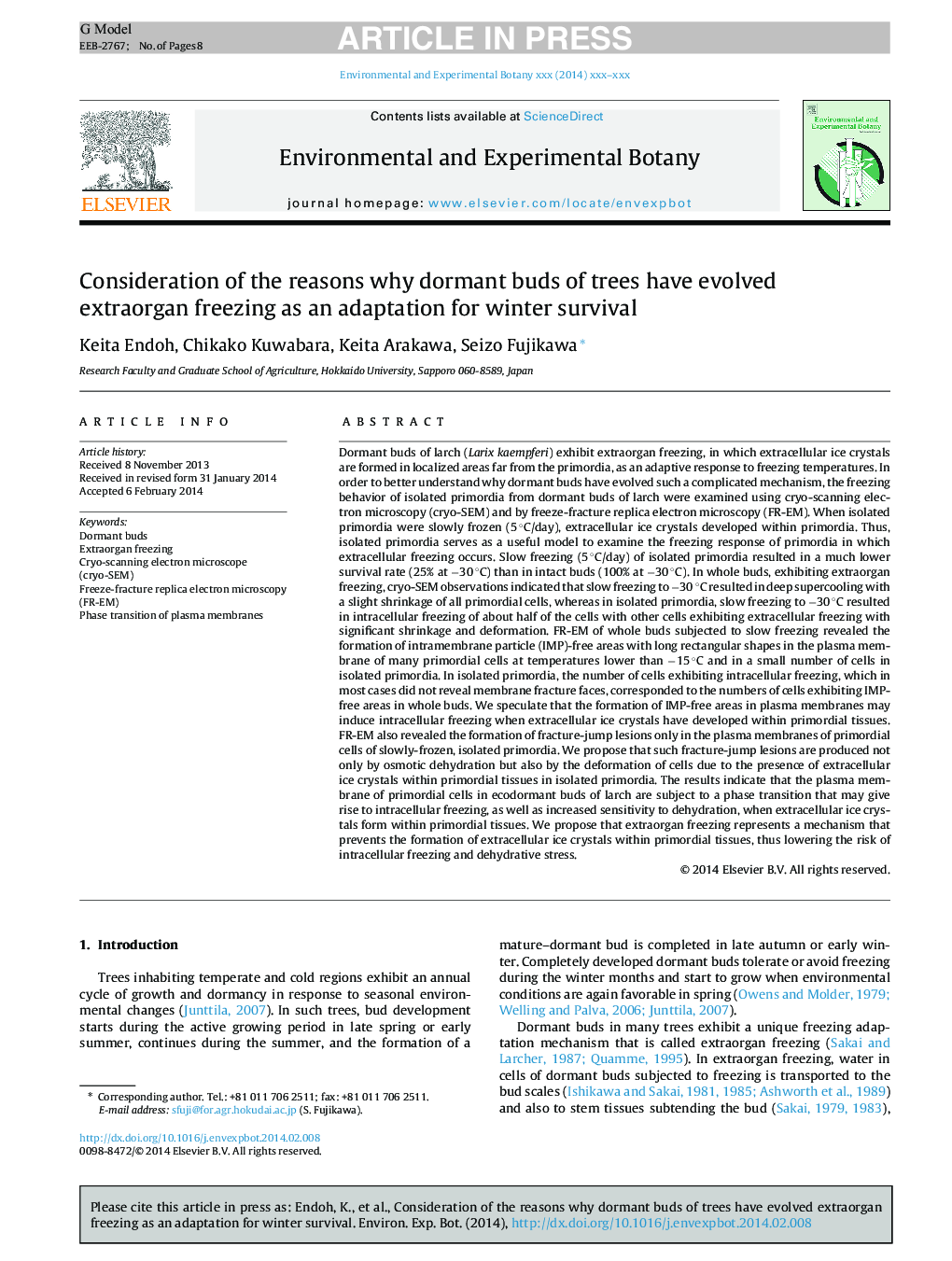| کد مقاله | کد نشریه | سال انتشار | مقاله انگلیسی | نسخه تمام متن |
|---|---|---|---|---|
| 6388867 | 1628071 | 2014 | 8 صفحه PDF | دانلود رایگان |
عنوان انگلیسی مقاله ISI
Consideration of the reasons why dormant buds of trees have evolved extraorgan freezing as an adaptation for winter survival
ترجمه فارسی عنوان
در نظر گرفتن دلایلی که جوانه های خفته درختان انجماد فوق العاده را به عنوان انطباق برای بقای زمستان توسعه داده اند
دانلود مقاله + سفارش ترجمه
دانلود مقاله ISI انگلیسی
رایگان برای ایرانیان
موضوعات مرتبط
علوم زیستی و بیوفناوری
علوم کشاورزی و بیولوژیک
بوم شناسی، تکامل، رفتار و سامانه شناسی
چکیده انگلیسی
Dormant buds of larch (Larix kaempferi) exhibit extraorgan freezing, in which extracellular ice crystals are formed in localized areas far from the primordia, as an adaptive response to freezing temperatures. In order to better understand why dormant buds have evolved such a complicated mechanism, the freezing behavior of isolated primordia from dormant buds of larch were examined using cryo-scanning electron microscopy (cryo-SEM) and by freeze-fracture replica electron microscopy (FR-EM). When isolated primordia were slowly frozen (5 °C/day), extracellular ice crystals developed within primordia. Thus, isolated primordia serves as a useful model to examine the freezing response of primordia in which extracellular freezing occurs. Slow freezing (5 °C/day) of isolated primordia resulted in a much lower survival rate (25% at â30 °C) than in intact buds (100% at â30 °C). In whole buds, exhibiting extraorgan freezing, cryo-SEM observations indicated that slow freezing to â30 °C resulted in deep supercooling with a slight shrinkage of all primordial cells, whereas in isolated primordia, slow freezing to â30 °C resulted in intracellular freezing of about half of the cells with other cells exhibiting extracellular freezing with significant shrinkage and deformation. FR-EM of whole buds subjected to slow freezing revealed the formation of intramembrane particle (IMP)-free areas with long rectangular shapes in the plasma membrane of many primordial cells at temperatures lower than â15 °C and in a small number of cells in isolated primordia. In isolated primordia, the number of cells exhibiting intracellular freezing, which in most cases did not reveal membrane fracture faces, corresponded to the numbers of cells exhibiting IMP-free areas in whole buds. We speculate that the formation of IMP-free areas in plasma membranes may induce intracellular freezing when extracellular ice crystals have developed within primordial tissues. FR-EM also revealed the formation of fracture-jump lesions only in the plasma membranes of primordial cells of slowly-frozen, isolated primordia. We propose that such fracture-jump lesions are produced not only by osmotic dehydration but also by the deformation of cells due to the presence of extracellular ice crystals within primordial tissues in isolated primordia. The results indicate that the plasma membrane of primordial cells in ecodormant buds of larch are subject to a phase transition that may give rise to intracellular freezing, as well as increased sensitivity to dehydration, when extracellular ice crystals form within primordial tissues. We propose that extraorgan freezing represents a mechanism that prevents the formation of extracellular ice crystals within primordial tissues, thus lowering the risk of intracellular freezing and dehydrative stress.
ناشر
Database: Elsevier - ScienceDirect (ساینس دایرکت)
Journal: Environmental and Experimental Botany - Volume 106, October 2014, Pages 52-59
Journal: Environmental and Experimental Botany - Volume 106, October 2014, Pages 52-59
نویسندگان
Keita Endoh, Chikako Kuwabara, Keita Arakawa, Seizo Fujikawa,
